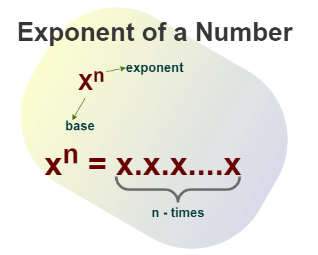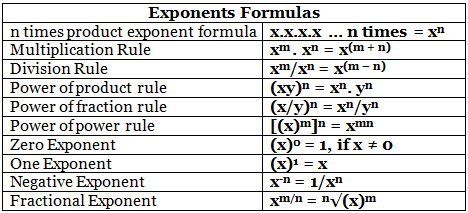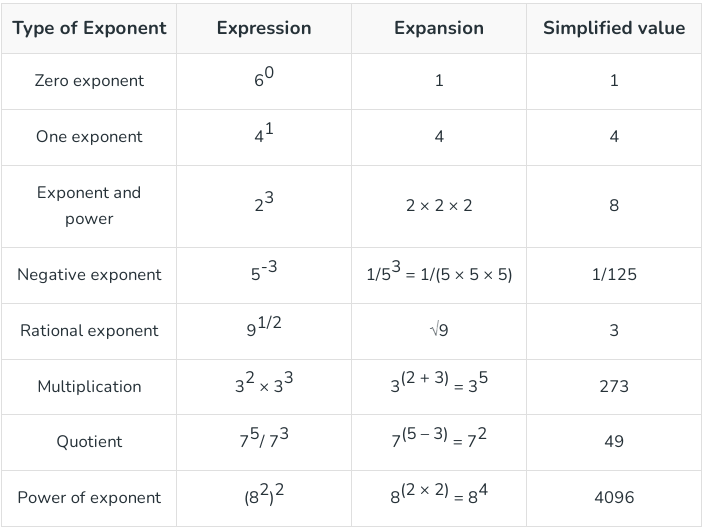Overview: Exponents | General Aptitude for GATE - Mechanical Engineering PDF Download
| Table of contents |

|
| Introduction |

|
| What are Exponents? |

|
| Exponents Definition |

|
| Laws of Exponents |

|
| Negative Exponents |

|
| Exponents with Fractions |

|
| Decimal Exponents |

|
| Scientific Notation with Exponents |

|
Introduction
Exponents are a fundamental concept in mathematics that assist in simplifying and comprehending very large numbers. For example, if we need to express 10 multiplied by itself 10 times, we write it as 1010, which is a much simpler notation. An exponent is also known as the power of a number. Exponents can be either integers or fractions, with fractional exponents often referred to as radicals.
What are Exponents?
When any number or variable (x) is multiplied n times, then the resultant is xn. Then, n is called the exponent of
x.x.x.x.x.x.x … n times = xn
Then x is base and n is an exponent of that base and this is read as x raises to power n. An exponent is the power of a number that indicates the number of times the number multiplied by itself. Exponent defines the number of times a number is multiplied by itself.
Example: 2.2.2 = 23
- Base = 2
- Exponent = 3
The concept of the exponent is represented in the image added below,

Exponents Definition
A mathematical way of representing very large numbers is called the exponents. It is a way of representing the powers of a number. Suppose we have a number 5 which is multiplied by itself 5 times then this is expressed as, 5×5×5×5×5
As we can see this is a very tedious way of representing the number in exponent this is represented as, 5×5×5×5×5 = 55
Thus, the exponent is a very short way of representing large numbers.
Exponents Formulas
The formulas that are widely used for solving the exponents are added in the table below,
 Note: If an equation base is the same we can equate the exponents.
Note: If an equation base is the same we can equate the exponents.
Laws of Exponents
There are seven laws of exponents that we study under this heading.
- Product of Power Rule: This rule states that two numbers in exponential having the same base are multiplied then their product contains the same base and their powers get added. For Example 23⨯24 = 23+4 = 27
- Quotient of Power Rule: This rule states that two numbers in exponential form is divided then the quotient has the same base and their powers get subtracted. For Example: 35/32 = 35-2 = 33
- Power of Power Rule: If a number in exponential form is raised to some power then its powers get multiplied. For Example, (43)2 = 43⨯2 = 46
- Power of a Product Rule: If two numbers in the exponential form that have the different bases but the same exponents are multiplied then the product has the base equal to the product of two bases and the power remains the same. For Example, 32⨯42 = 122 = 144
- Power of Quotient Rule: If two numbers in the exponential form that have a different base but the same exponents are divided then the quotient has the base equal to the quotient of two bases and the power remains the same. For Example, 63/33 = 23 = 8
- Zero Exponent Rule: Any number raised to power zero gives 1. For Example, (101)0 = 1
- Negative Exponent Rule: If any number is raised to negative power then to make the power positive, the base is converted to its reciprocal. For Example, 2-3 = (1/2)3 = 1/23 = 1/8
Negative Exponents
Negative Exponent is nothing but the exponents of the reciprocal numbers thus, negative exponents are easily solved by taking the reciprocal and then easily solving the exponent using the normal rules. This is represented as,
x-n = (1/x)n
Suppose we have to solve for the negative exponent (2)-3 then,
(2)-3 = (1/2)3 = 1/8
Thus, taking the exponent easily solves the exponents. All the formulas of the exponents work easily with the negative exponents.
Exponents with Fractions
The exponents with the fraction are also called the radicals. These are the exponents that have a fraction of their power. The square root, cube root, nth root, and others all are called exponents with fractions.
We represent the fraction exponents as,
- Square Root = √()
- Cube Root = 3√()
- nth Root = n√()
Now the fraction exponent is solved in two parts in the first part we solve the denominator and then solve the numerator, this is represented as,
xn/m = {(x)1/m}n
here, we first solve (x)1/m and then take its nth power to get the final answer. This can be understood by the example added below,
Example: Simplify 43/2
Sol:
= 43/2
= (41/2)3
= 23 = 8
Decimal Exponents
Decimal Exponents are nothing but the other way of representing the fraction exponents. If any exponent is given in the decimal form then we first change it into fraction form and then easily solve for the fraction form.
This can be understood by the example added below,
Example: Simplify 41.5
Sol:
= 41.5 (As, 1.5 = 3/2)
= 43/2
= (41/2)3
= 23 = 8
Exponent Table

Scientific Notation with Exponents
Scientific Notation is a way of writing very large numbers into very small numbers. In scientific notation, the numbers are represented in the multiple of 10. The number is first converted into its unit form and then the number is multiplied with the power of 10 to get the number in scientific notation.
These numbers are useful in writing very large and very small numbers. Suppose we have to write 15670000 then in scientific notation it is represented as, 1.567×107
Any number can be easily represented in the scientific notation by following the steps added below,
- Step 1: If the number is greater than one mark the decimal digit after the first digit from the starting of the number.
- Step 2: Then multiply the number with the 10 raise to the power as their are digits after the decimal or point (include zero in the counting)
- Step 3: If the number is smaller than one shift the decimal to the first digit counting from the left of the number excluding zeros.
- Step 4: Then multiply the number with the 10 raise to the negative power as their are digits from which the decimal is shift.
Example 1: Convert 134500000000 into scientific notation.
Sol:
= 134500000000
= 1.345 × 1011
Example 2: Convert 0.0000001345 into scientific notation.
Sol:
= 0.0000001345
= 1.345 × 10-7
|
193 videos|169 docs|152 tests
|
FAQs on Overview: Exponents - General Aptitude for GATE - Mechanical Engineering
| 1. What is the definition of exponents in mathematics? |  |
| 2. What are the laws of exponents and how do they work? |  |
| 3. How do negative exponents work and what do they represent? |  |
| 4. How can exponents be used with fractions in mathematical expressions? |  |
| 5. What is scientific notation and how is it related to exponents in mathematics? |  |




















